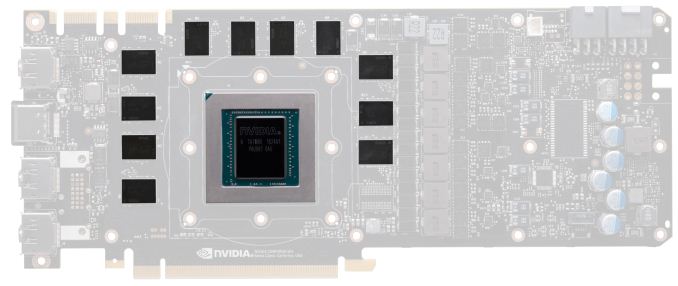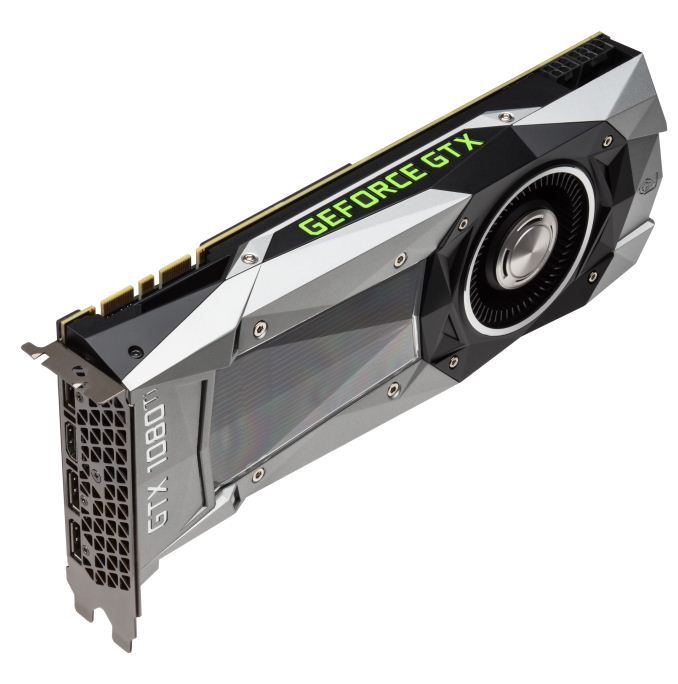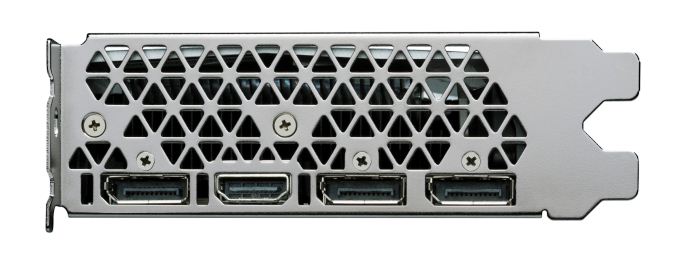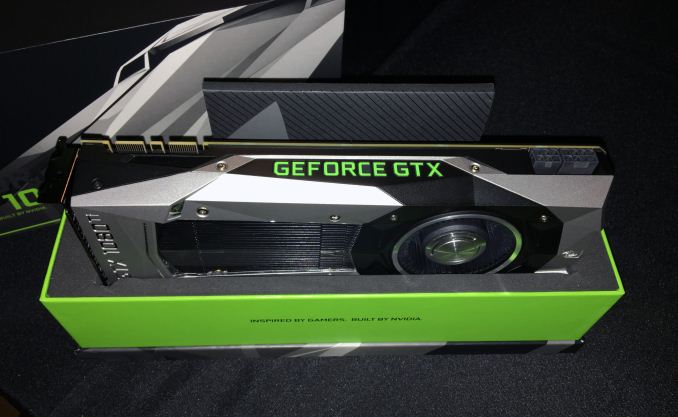Nvidia Geforce Gtx 1080 Ti Teraflops
In what has at present become a bona fide tradition for NVIDIA, at their GDC event this evening the visitor announced their next flagship video card, the GeForce GTX 1080 Ti. Something of a poorly kept clandestine – NVIDIA'due south website accidentally spilled the beans last week – the GTX 1080 Ti is NVIDIA'south large Pascal refresh for the year, finally rolling out their well-nigh powerful consumer GPU, GP102, into a GeForce video card.
The Ti series of cards isn't new for NVIDIA. The company has used the moniker for their higher-performance cards since the GTX 700 series back in 2013. However no ii generations accept really been akin. For the Pascal generation in particular, NVIDIA has taken the almighty Titan line in a more professional direction, so whereas a Ti card would be a value Titan in past generations – and this is however technically truthful here – it serves as more of a flagship for the Pascal generation GeForce.
At whatever rate, we knew that NVIDIA would release a GP102 carte for the GeForce market sooner or later, and at long last information technology'due south here. Based on a not-quite-fully-enabled GP102 GPU (more than on this in a second), like its predecessors the GTX 1080 Ti is meant to serve every bit a mid-generation performance boost for the high-end video carte market. In this case NVIDIA is aiming for what they're calling their greatest performance jump yet for a Ti product – around 35% on average – which would translate into a sizable upgrade for GeForce GTX 980 Ti owners and others for whom GTX 1080 wasn't the menu they were looking for.
| NVIDIA GPU Specification Comparison | ||||||
| GTX 1080 Ti | NVIDIA Titan X | GTX 1080 | GTX 980 Ti | |||
| CUDA Cores | 3584 | 3584 | 2560 | 2816 | ||
| Texture Units | 224 | 224 | 160 | 176 | ||
| ROPs | 88 | 96 | 64 | 96 | ||
| Cadre Clock | ? | 1417MHz | 1607MHz | 1000MHz | ||
| Boost Clock | 1582MHz | 1531MHz | 1733MHz | 1075MHz | ||
| TFLOPs (FMA) | xi.3 TFLOPs | xi TFLOPs | nine TFLOPs | 6.one TFLOPs | ||
| Retentivity Clock | 11Gbps GDDR5X | 10Gbps GDDR5X | 10Gbps GDDR5X | 7Gbps GDDR5 | ||
| Retentiveness Autobus Width | 352-bit | 384-bit | 256-bit | 384-bit | ||
| VRAM | 11GB | 12GB | 8GB | 6GB | ||
| FP64 | i/32 | 1/32 | ane/32 | one/32 | ||
| FP16 (Native) | i/64 | 1/64 | 1/64 | N/A | ||
| INT8 | four:1 | iv:1 | Northward/A | North/A | ||
| TDP | 250W | 250W | 180W | 250W | ||
| GPU | GP102 | GP102 | GP104 | GM200 | ||
| Transistor Count | 12B | 12B | vii.2B | 8B | ||
| Die Size | 471mm2 | 471mm2 | 314mm2 | 601mm2 | ||
| Manufacturing Procedure | TSMC 16nm | TSMC 16nm | TSMC 16nm | TSMC 28nm | ||
| Launch Engagement | 03/2017 | 08/02/2016 | 05/27/2016 | 06/01/2015 | ||
| Launch Price | $699 | $1200 | MSRP: $599 Founders $699 | $649 | ||
We'll start every bit always with the GPU at the eye of the carte du jour, GP102. With NVIDIA's business now supporting a dedicated compute GPU – the immense GP100 – GP102 doesn't qualify for the "Large Pascal" moniker like past iterations accept. Only make no mistake, GP102 is quite a bit larger than the GP104 GPU at the heart of the GTX 1080, and that translates to a lot more hardware for pushing pixels.

GTX 1080 Ti ships with 28 of GP102's 30 SMs enabled. For those of yous familiar with the not-quite-consumer NVIDIA Titan 10 (Pascal), this is the same configuration every bit that bill of fare, and in fact there are a lot of similarities betwixt those two cards. Though for this generation the state of affairs is non going to exist cut & dry as in the past; the GTX 1080 Ti is not strictly a subset of the Titan.
The big difference on the hardware front is that NVIDIA has stripped GP102 of some of its retention/ROP/L2 capacity, which was fully enabled on the Titan. Of the 96 ROPs nosotros get 88; the last ROP block, its retentiveness controller, and 256KB of L2 enshroud have been disabled.

Withal what the GTX 1080 Ti lacks in functional units it's partially making up in clockspeeds, both in regards to the cadre and the memory. While the base of operations clock has not yet been disclosed, the heave clock of the GTX 1080 Ti is 1582MHz, virtually 50MHz higher than its Titan counterpart. More significantly, the retentiveness clock on the GTX 1080 Ti is 11Gbps, a 10% increase over the 10Gbps clock found on the Titan and the GTX 1080. Combined with the 352-bit retention omnibus, and we're looking at 484GB/sec of retentiveness bandwidth for the GTX 1080 Ti.

Taken altogether then, the GTX 1080 Ti offers just over 11.iii TFLOPS of FP32 operation. This puts the expected shader/texture operation of the bill of fare 28% alee of the current GTX 1080, while the ROP throughput reward stands 26%, and retentivity bandwidth at a much greater 51.2%. Real-globe functioning volition of course be influenced by a alloy of these factors, so I'll exist curious to see how much the major jump in retention bandwidth helps given that the ROPs aren't seeing the same kind of throughput boost. Otherwise, relative to the NVIDIA Titan X, the two cards should cease up quite close, trading blows now and and then.
Speaking of the Titan, on an interesting side note, it doesn't look similar NVIDIA is going to exist doing anything to hurt the compute performance of the GTX 1080 Ti to differentiate the card from the Titan, which has proven popular with GPU compute customers. Crucially, this means that the GTX 1080 Ti gets the same 4:1 INT8 operation ratio of the Titan, which is disquisitional to the cards' high neural networking inference performance. Equally a effect the GTX 1080 Ti actually has slighty greater compute operation (on paper) than the Titan. And NVIDIA has been surprisingly candid in admitting that unless compute customers need the final 1GB of VRAM offered by the Titan, they're likely going to buy the GTX 1080 Ti instead.

Speaking of memory, as I mentioned before the carte du jour will be shipping with eleven pieces of 11Gbps GDDR5X. The faster retention clock comes courtesy of a new generation of GDDR5X memory chips from partner Micron, who after a fleck of a rocky start with GDDR5X development, is finally making progress on boosting retention speeds that definitely has NVIDIA pleased. Until now NVIDIA's GPUs and boards accept been gear up for the higher frequency retention, and the memory is simply now catching up.
Moving on, the card's 250W TDP should not come up equally a surprise. This has been NVIDIA's segment TDP of choice for Titan and Ti cards for a while at present, and the GTX 1080 Ti isn't deviating from that.

Yet the cooling system has seen a small only of import overhaul: the DVI port is gone, opening upwards the card to exist a full slot blower. In social club to offer a DVI port along with a number of DisplayPorts/HDMI ports, NVIDIA has traditionally blocked part of the carte's second slot to house the DVI port. But with GTX 1080 Ti, that port is finally gone, and that gives the GTX 1080 Ti the interesting distinction being the get-go unobstructed high-stop GeForce menu since the GTX 580. The end result is that NVIDIA is promising a decent increase in cooling performance relative to the GTX 980 Ti and like designs. Nosotros'll take to encounter how NVIDIA has tuned the card to empathise the total impact of this change, but this likely will further improve on NVIDIA's already great acoustics.
Meanwhile the end issue of removing the DVI port means that the GTX 1080 Ti's display I/O has been pared downwards to just a mix of HDMI and DisplayPorts. Altogether we're looking at 3x DisplayPort 1.4 ports and 1x HDMI 2.0 port. As a alleviation to owners who may nevertheless be using DVI-based monitors, the company will be including a DisplayPort to DVI adapter with the menu (presumably DP to SL-DVI and not DL-DVI), just it's articulate that DVI's days are at present numbered over at NVIDIA.
Moving on, for card designs NVIDIA is once again going to be working with partners to offer a mix of reference and custom designs. The GTX 1080 Ti will initially exist offered in a Founder'due south Edition pattern, while partners are also bringing up their own semi and fully custom designs to be released a chip later on. Importantly however, dissimilar the GTX 1080 & GTX 1070, NVIDIA has done abroad with the Founder's Edition premium for the GTX 1080 Ti. The MSRP of the card will be the MSRP for both the Founder's Edition and partners' custom cards. This makes pricing more consequent, though I'thou curious to see how this plays out with partners, as they benefitted from the premium in the form of more bonny pricing for their own cards.

Finally, speaking of pricing, allow'southward talk about the launch date and availability. Just in time for Pi Mean solar day, NVIDIA will be launching the carte du jour on the week of March 5th (Update: an verbal engagement has finally been revealed: Friday, March tenth). Equally for pricing, long-time cost watchers may be surprised. NVIDIA will exist releasing the carte at $699, the old price of the GTX 1080 Founder's Edition (which itself just got a toll cut). This does work out to a fleck college than the GTX 980 Ti - information technology launched at $649 two years ago - merely it's more aggressive than I had been expecting given the GTX 1080's launch toll last year.
In any case, at this time the high-end video card market is NVIDIA'south to command. AMD doesn't offer anything competitive with the GTX 1070 and in a higher place, so the GTX 1080 Ti will stand alone at the summit of the consumer video card market. Long-term here AMD isn't hesitating to annotation their work on Vega, but that's a bridge to be crossed but once those cards get here.
Source: https://www.anandtech.com/show/11172/nvidia-unveils-geforce-gtx-1080-ti-next-week-699
Posted by: watkinsniess1969.blogspot.com

0 Response to "Nvidia Geforce Gtx 1080 Ti Teraflops"
Post a Comment